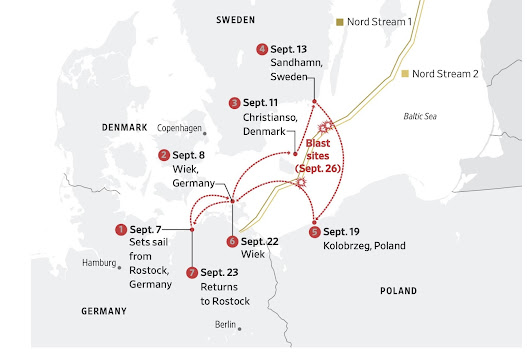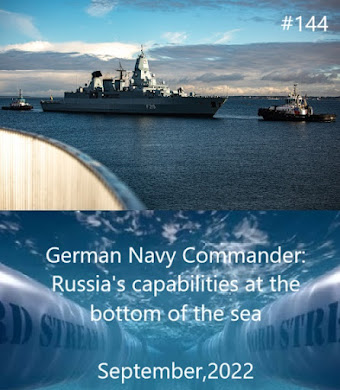So what will happen now?
(With Nord Stream 2 AG project)
SUMMARY:
In February 2022, Germany suspended the Nord Stream 2 pipeline project
amid escalating tensions due to the conflict in Ukraine.
This decision halted the certification process for the pipeline
but does not signify its complete abandonment.
Despite this suspension,
Germany's energy strategy remains focused on importing gas,
though there are long-term goals for CO2-neutral energy sources.
KEY TAKEAWAYS:
Impact of Suspension: While the suspension does not immediately affect gas supplies since Nord Stream 2 was not operational, it raises concerns about supply risks for subsequent winters if the Ukraine conflict continues and sanctions remain in place.
Demand Reduction Proposal: A potential solution is to decrease gas demand instead of seeking new suppliers.
Legal Implications: Nord Stream 2 AG may pursue legal action for compensation from the German government, claiming legitimate expectations based on prior permits. However, the political shifts stemming from the Ukraine crisis might complicate the legitimacy of this claim.
Supply Security Assessment: The German government has a supply security assessment process that can be adapted based on significant changes, such as Russia's aggression and inconsistencies in gas deliveries. The European Commission also plays a role in reviewing these assessments
DATA:
Those questions are: is Nord Stream 2 dead? Will Germany’s gas strategy change? How will it change the current official assessment of Germany and the EU’s security of supply? Can Nord Stream 2 AG sue Germany? Will Germany build its first LNG import terminal? What are the reactions from German and European Stakeholders?
1. What’s the significance of the decision to suspend the approval process? Is Nord Stream 2 dead?...he decision does not necessarily mark the end of Nord Stream 2, which was completed in September 2021. For now, the government made use of a regulatory tool to halt the certification...
2. Does the German government reassess its position on natural gas with the decision?... “Germany is and will remain an importing country for energy, even if the energy sources will be CO2-neutral in the long term,”...
3. What does the decision mean for supply security in Germany and Europe?
...
Germany and many other European countries rely on Russian supplies to cover a high share of their energy needs. About half of Germany’s, and more than 40 percent of the EU’s, natural gas imports currently come from Russia and the country is also the main external supplier of coal and oil products to Europe. However, as
Nord Stream 2 has not yet begun operation, stopping the pipeline’s completion alone would not mean any changes to current supply capacities...
the risk increases if the conflict and accompanying sanctions drag on until next winter. A straightforward response would be to reduce the amount of gas needed, rather than looking for new suppliers, the think tank concluded: “Whatever happens, the most efficient solution requires demand-side adjustments to reduce dependency on gas.”...
4. Can stopping Nord Stream 2 have legal repercussions for the German government?If German authorities put a final stop to the use of the completed pipeline, the Nord Stream 2 company will likely resort to legal action. The German government could be faced with a compensation claim brought forward by the Nord Stream 2 AG operator...
...Before the court, the legitimate expectations of the plaintiff, for example positive signals given to Nord Stream 2 by receiving construction permits for the pipeline, are important arguments; while a changing political situation, even if caused by a crisis like the one in Ukraine, does not count as a valid argument, legal expert Gabriel Lentner told Tagesspiegel Background...
The ministry stressed that the supply security assessment (completed by the previous government in its very last weeks in office) is “based on an analysis of factual and legal fundamentals and can or must be adjusted in the event of a change in significant factual fundamentals” (Section 4b (3) EnWG). Both Russia’s aggression in Ukraine and patchy gas deliveries from Russia this winter are counting as such a change in “factual fundamentals”, minister Habeck indicated. How vulnerable the report will be to future legal action depends a lot on its actual wording and reasoning on how Nord Stream 2 endangers Germany’s supply security, legal experts told Die Welt. After the German government’s assessment, the European Commission also gets a say.
NOTE: [MRT: Read the full report]
COMPARISON BETWEEN PIPED AND LIQUIFIED GAS
Price: Russian piped gas through Nord Stream was significantly cheaper than LNG. Estimates suggest Nord Stream gas landed in Germany at around $4–$5 per million British thermal units (mmBtu), based on Gazprom’s long-term contract pricing tied to oil indexes and spot market trends at the time. This reflected low transportation costs—direct pipeline delivery avoided liquefaction, shipping, and regasification expenses. In contrast, LNG, primarily from the U.S. or Qatar, cost Europe $10–$15 per mmBtu in 2021, depending on global demand, shipping rates, and terminal fees. U.S. LNG, for instance, started at the Henry Hub price (~$2.50–$3/mmBtu in 2021), but liquefaction ($3–$4/mmBtu), transatlantic shipping ($1–$2/mmBtu), and regasification ($1–$2/mmBtu) inflated the total. Russian gas thus held a cost advantage of roughly 50–70% over LNG, bolstered by its proximity and fixed infrastructure.
Speed: Pipeline gas also outpaced LNG in delivery speed. Nord Stream 1, operational since 2011, transported gas from Russia to Germany in about 2–3 days, flowing continuously at up to 55 billion cubic meters (bcm) annually. Nord Stream 2, completed in 2021 but not yet operational, promised to double this capacity with similar efficiency. LNG, however, faced longer timelines: liquefaction took hours, shipping from the U.S. Gulf Coast to Europe spanned 10–14 days, and regasification added another day or two. Total transit time for LNG was typically 2–3 weeks, with scheduling rigidities (e.g., 30-day notice for changes) versus the day-ahead flexibility of pipeline nominations. This made piped gas far more responsive to immediate demand.
In short, in 2021, Nord Stream gas was both cheaper ($4–$5/mmBtu vs. $10–$15/mmBtu for LNG) and faster (2–3 days vs. 2–3 weeks), underscoring why it was a cornerstone of Europe’s energy strategy before geopolitical shifts intervened.
***
***
Uncovering the truth took over two years of self-funded, tireless investigation.
I decided to open it for free, no paywall, despite huge investment.
Because the truth matters.
Please consider supporting my work with a donation.

Every bit helps keep this mission alive!
(retweet and follow)





































